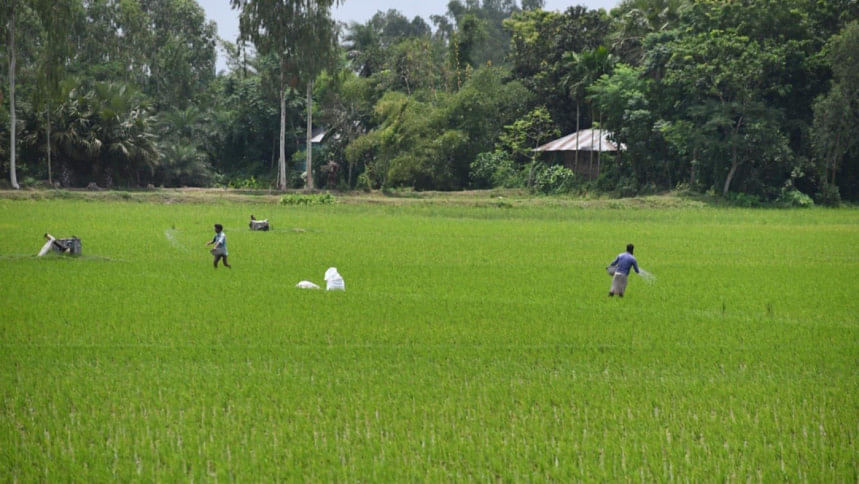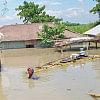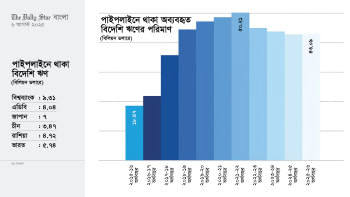Climate change demands better forecasts for farmers

Agriculture, the bedrock of Bangladesh's economy and a direct source of sustenance for millions, is facing unprecedented challenges due to the escalating climate crisis. From the paddy fields of Dinajpur to the shrimp farms in Khulna, the nation's agricultural sector is facing heightened uncertainty. So, farmers are questioning the reliability of existing weather and climate forecasts. This critical juncture brings into sharp focus the imperative for accurate and dependable meteorological data to safeguard harvests and ensure food security.
While the terms "weather" and "climate" are often used interchangeably, they refer to distinct concepts that play different roles in agriculture. Weather relates to short-term atmospheric conditions, for instance, whether it will rain tomorrow or be sunny later this week. It helps farmers make daily decisions such as when to irrigate, apply fertiliser, or delay harvesting due to an approaching storm.
Climate, on the other hand, concerns long-term patterns over decades. It provides projections that help assess how rising temperatures, shifting rainfall, and salinity levels might affect agriculture over the next 10, 20, or even 50 years. This long-term view informs decisions about crop variety selection, suitable cultivation zones, and the adoption of new technologies for resilience.
In a country like Bangladesh, which is highly vulnerable to climate change, understanding both weather and climate is not a choice—it is a necessity. The key lies in using both effectively to ensure sustainability in agriculture.
Consider a farmer in Rajshahi, a region increasingly facing drought. For immediate planning, the farmer might rely on a five-day weather forecast to time irrigation or pest control. However, if climate projections indicate a 15 percent drop in rainfall over the next 20 years, continuing with water-intensive crops could prove risky. In such cases, climate forecasts offer valuable guidance for switching to drought-tolerant crops, adopting water-efficient technologies, or adjusting planting seasons. Ignoring these projections may lead to unsustainable farming practices.
Similarly, in the coastal regions of Satkhira and Bagerhat, rising salinity has made weather forecasts vital for storm preparedness. However, the long-term implications of sea-level rise and increasing salinity inland can only be understood through climate models. These projections suggest a transition towards saline-tolerant rice or aquaculture. Without integrating such insights, communities risk losing their livelihoods to creeping environmental changes.
Despite the rising importance of both weather and climate data, many Bangladeshi farmers lack access to timely and accurate information. The Bangladesh Meteorological Department (BMD) does provide weather updates, and institutions such as the Bangladesh Rice Research Institute (BRRI) and the Bangladesh Agricultural Research Institute (BARI) conduct climate-related research. However, the integration of this information into on-the-ground advisories remains limited.
A nationwide agro-meteorological advisory system that combines near-term weather forecasts with long-term climate projections is required. Such a system would allow farmers to make informed decisions not only for the present but also for the coming decades. Effective communication channels—such as mobile apps, community radio, agricultural extension services, and farmer training—can help deliver this information in formats that are easy to understand and act upon.
Bangladesh's agriculture has long been reactive, responding to events as they unfold. However, as climate change becomes more unpredictable, this approach is no longer sufficient. The sector must evolve into a more resilient system that anticipates and adapts to change. This shift requires climate-smart agriculture that draws on both real-time weather updates and long-term climate forecasts. Key interventions include promoting crop diversification based on future suitability; developing and distributing climate-resilient seed varieties; investing in early warning systems and crop insurance; and training workers of the Department of Agricultural Extension (DAE) to interpret and share climate data effectively. These are not optional upgrades; they are crucial for ensuring food security and protecting rural livelihoods.
The government has made notable progress through the National Adaptation Plan and the Delta Plan 2100. Yet, these frameworks need stronger linkages to farming communities. This involves allocating resources to develop accessible climate information services, fostering coordination among BMD, Bangladesh Water Development Board (BWDB), BRRI, BARI, Bangladesh Institute of Nuclear Agriculture (BINA), DAE, and local authorities, and embedding climate risk literacy into agricultural training programmes. Investing in climate and weather awareness today can help avoid billions in crop losses tomorrow.
In an era of climate volatility, even a delayed monsoon or an early heatwave can wipe out months of effort. With accurate forecasts—whether for the next week or the next 20 years—farmers can plan, adapt, and thrive. For Bangladesh, an agrarian economy, weather and climate forecasts must be seen as essential tools for survival. Every farmer, from the chars of Kurigram to the coastal plains of Barishal, must know not only if it will rain tomorrow, but whether their fields will still be productive in the decades ahead. Ultimately, the forecast, not just the seed, will shape the harvests of the future.
Niaz Md. Farhat Rahman is principal scientific officer and weather and climate change researcher at the Agricultural Statistics division of the Bangladesh Rice Research Institute (BRRI). He can be reached at [email protected].
Views expressed in this article are the author's own.
Follow The Daily Star Opinion on Facebook for the latest opinions, commentaries, and analyses by experts and professionals. To contribute your article or letter to The Daily Star Opinion, see our guidelines for submission.

 For all latest news, follow The Daily Star's Google News channel.
For all latest news, follow The Daily Star's Google News channel. 









Comments